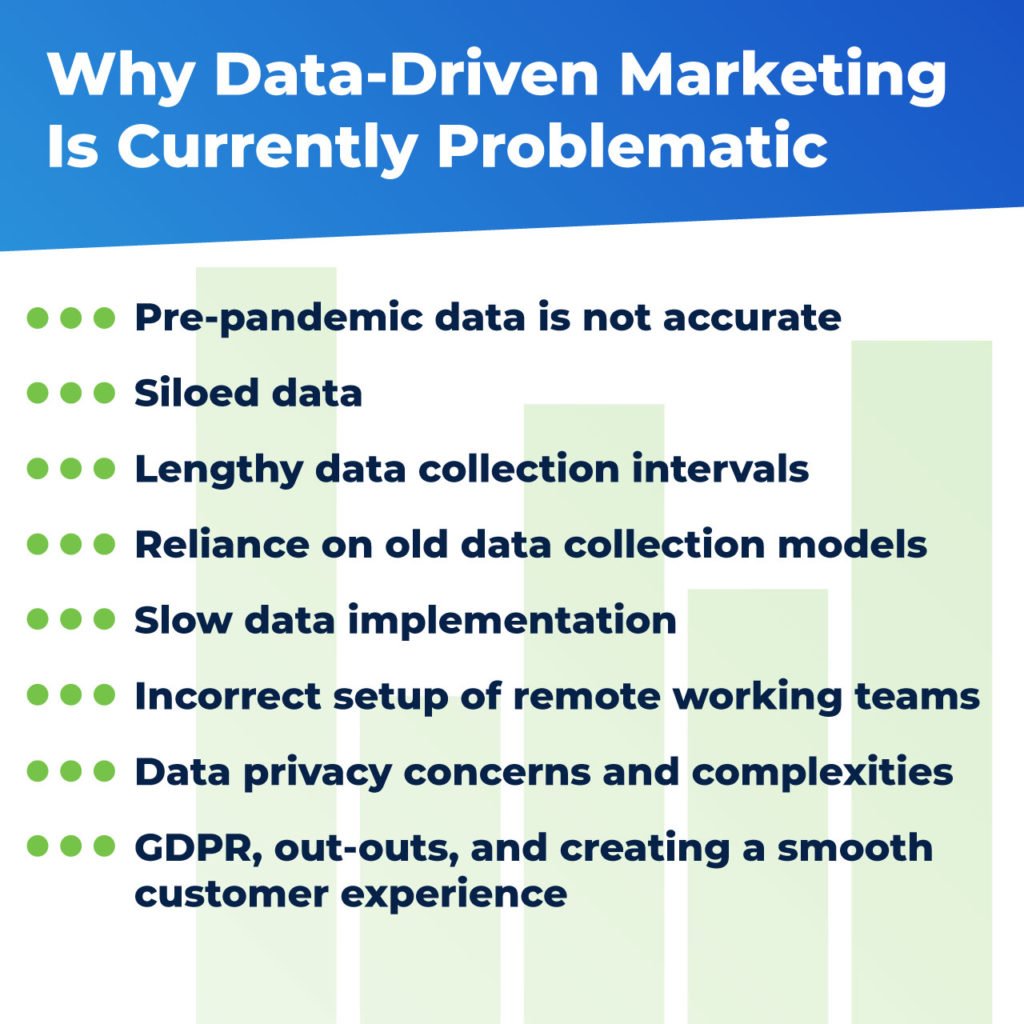The global pandemic sparked an eCommerce growth spurt of 4-6 years, which might naturally make you think these are exciting times for marketers, especially with all the data-driven marketing tools they have at their fingertips, right?
Well, not exactly. Consumer behavior patterns have been totally scrambled, which means marketers can no longer rely on traditional data marketing models. For example, is reduced store visitation a result of uninterested customers, or because they can’t physically get to the store? Marketers don’t know because they can’t trust their data.
Without an effective strategy for moving forward, hordes of marketers regressed to ineffective mass marketing strategies. The fallout for the industry is that 64% of CMO’s had their marketing budget cut.
Are you having trouble getting the results you once did with your data marketing campaigns? Examining the problems of how we got here is a good place to start for paving the way forward. Let’s take a look at the main issues to figure out what’s happening with the current data-driven marketing landscape.

Pre-pandemic Data Is Not Accurate
The digital data marketing model is created by capturing a variety of data over a long time span. Theoretically, more data depth and volume equates to a more accurate model. The problem with some marketing models is that they rely on pre-pandemic data.
Is that the case for your team? The problem is that customers are behaving differently and current data models are not able to capture that behavioral shift. Consequently, you’re making false predictions on where to spend marketing dollars resulting in lackluster ROI.
Furthermore, a new breed of online shoppers has emerged because of the pandemic. People that used to exclusively go to their local hardware store or shopping mall, had no choice but to start venturing online for those same purchases. These online newcomers may not have the same shopping patterns as experienced online shoppers.
Is data-driven marketing doomed? Not by a long shot. Upgrading marketing models will be the next big challenge for data marketers. Switching back to dated mass marketing strategies will not win you the lion’s share of the attention and sales. Marketers that adapt their models will learn to acquire effective datasets.
Data Collection Is Part of the Problem
Figuring out what data to capture and where to pay attention is one of the challenges. Post-pandemic teams need to think outside the box to beat the competition. Here are 3 data collection problems that you want to avoid:
- Siloed data: the data capture process should involve cross-referencing with all departments. However, this typically isn’t possible for security reasons or technical limitations. Creating standard formats and aggregation tools across departments ensures more data is available.
- Lengthy intervals: teams that are creating long-term data collection plans without regular updates are missing out on key information. Post-pandemic the marketing landscape is more agile. Important new datasets might come and go every few weeks. However, if you only have meetings every quarter, then you’ll miss out on potentially lucrative trends.
- Reliance on old models: data collection should be focused on metrics that can be deployed to create profitable marketing campaigns. Continuing to record data using old frameworks, adds to the noise and could ultimately lead to the wrong conclusions.
Data Implementation Is Too Slow
The time taken to record, digest and implement data takes too long. By the time it’s put in action, the data is no longer accurate. The CEO of Mutiny, Jaleh Rezaei shares that “speed is the single most critical — and most overlooked — characteristic of a winning marketing team.”
Slow processes are not ideal for experimentation, which is exactly what’s needed right now. Marketing teams need to try out different tactics and hone their skills to figure out what post-pandemic strategies work best. However, if it takes months for the data sitting in your CRM (Customer Relationship Management) software to be looked at, then you are fighting an uphill battle.
The philosophy should be to work fast, make mistakes, learn from them and implement the lesson learned. Rapid experimentation allows marketers to seize the opportunities in front of them and significantly improve campaign ROI.
Incorrect Setup of Remote Working Teams
The pandemic has shifted a record number of people into remote work. It has worked well for some that enjoy the lack of a commute, but it’s challenging for others that need the schedule of an office to function. However, for many companies, it appears that the benefits of remote work mean it could turn into a long-term arrangement. The shift saves an average of $248 per month for employees and organizations $11,000 per year.
So what’s the problem? Many remote teams have teething pains as they figure out the tools available within their new work environment. In an office, you can pull people aside for a quick meeting and iron out critical issues. Now, to plan the same meeting digitally you may have to wait days and go through Zoom scheduling software.
A study examined 5,250 teams working in remote and co-location settings. They found that remote teams completed successful projects faster than co-location teams. The idea is that online teams can draw from a wider pool of expertise, not hindered by geographic location. However, the study also concluded that remote teams worked on failed projects for longer, which means they failed slower. In the context of data marketing, it explains why marketers may hold onto datasets and theories for longer than they should.
Data Privacy Complicates Data-Driven Marketing
An estimated 97% of consumers are somewhat or very concerned about personal data collection. The widespread dissatisfaction with how companies have misused data means that marketers have a harder time creating precision marketing campaigns. In fact, 73% of marketers fear that their analytics capabilities will be negatively affected by privacy issues.
However, it goes deeper than analytics. Marketers are effectively the gatekeepers of brand image. Playing dice with privacy laws could lead to mistakes that result in serious hits to the brand value. Therefore, extra resources need to be allocated toward ensuring data privacy laws are upheld, which eats into marketing profits.
The issue is somewhat ironic since 63% of consumers want their promotional offers to have personalization. That’s only possible with data collection. The challenge is to meet the personalized marketing demand without stepping on the toes of legislators.
3 Data Collection Hurdles
The laws dictating how brands should interact with consumers are becoming increasingly tough to deal with for marketers. Here are 3 of the biggest data privacy compliance takeaways:
- Informed consent: the GDPR demands that consumers give informed consent when data is collected or shared. Once consent is given, marketers are responsible for the flow of data within their ecosystem.
- Opt-outs: the CCPA requires that marketers accurately deal with customers that have requested to opt-out. You need to isolate those customers and make sure they are parsed out from marketing lists.
- Smooth customer experience: companies must reduce the friction required for consumers to opt out. The process must be secure and deliver a quality experience. It’s been a difficult task to navigate for marketing teams that harness huge volumes of data.
How Can Companies Overcome Data Privacy Challenges?
With over 66% of countries having data privacy legislation, it’s important to build marketing models from the ground up that comply with privacy standards. Creating a strict framework for how data is recorded, processed and shared, helps future-proof your marketing team against incoming legislation.
Don’t use a checkbox compliance approach. Instead, be proactive about protecting customer private data. Bring all departments into one compliance workflow that creates a smooth process. However, you’ll need to decide if you should tackle the issue at regional levels or globally – after all, the laws differ around the world.
Data minimization is also effective for reducing the chances of something going wrong. Focus on the data that you are only going to use. Discard what you don’t need anymore to avoid potential liability in the future.
Final Thoughts
The data-driven marketing landscape is in a state of fierce competition where you must adapt, evolve, and do it fast. You can’t rely on pre-pandemic data models, have slow data implementation strategies, and ineffective remote working teams. It’s tempting to deploy traditional marketing models, but change is the only way forward.
The problems mentioned above will remain a thorn in your side until you begin to see them as opportunities. Each one you overcome means you’re outcompeting other marketing teams that are still scratching their heads.
Excited about the possibilities that await from the huge potential of the exploding eCommerce market? To learn how to navigate these choppy waters read our next article on 3 Things you can do for successful Data-Driven Marketing in the New Normal.



